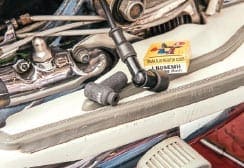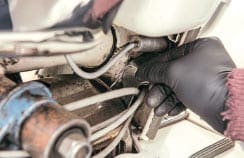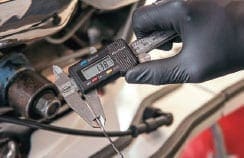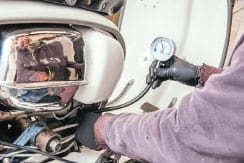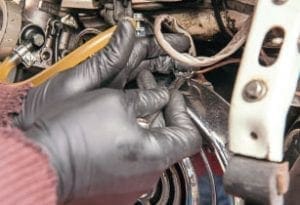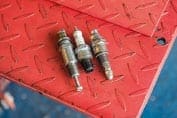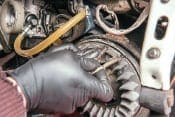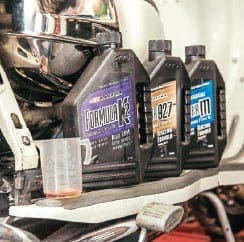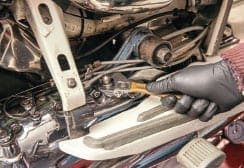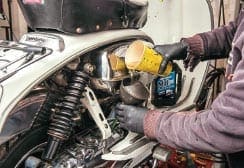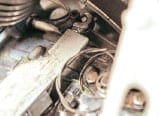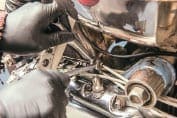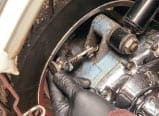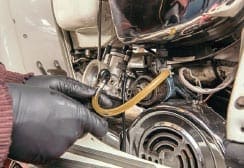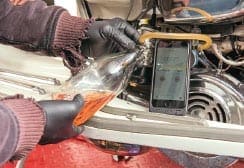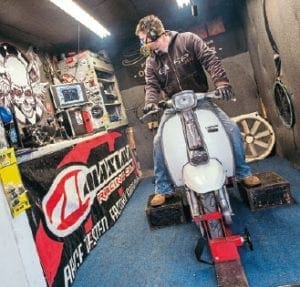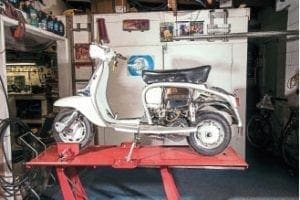The simple way to a trouble-free summer in 12 simple checks, 1 dyno session, and less money than a decent night out. Scootering’s new dep-ed Dan tells you how, Lambretta Vespa repairs.

Breaking down might be commonplace when you ride a fifty year-old Italian scooter, but it is not inevitable. A few hours spent on some simple checks before the season starts can save an awful lot more sat at the roadside waiting for a ‘very nice man’ in a Transit to show up. Most can be done at home, but if you’re not so sure then your local spanner monkey can sort them for you for the cost of a few hours’ labour. This feature is split into two parts. Checking that the basics are right and then fine-tuning on a dyno.
This scooter is deceased…..
I’ve lost count of the times a customer comes in with an expired engine, saying (and I quote) “I can’t understand why it broke…it was dynoed only last month”.
It’s a common misconception that a dyno session cloaks a scooter in a magic reliability-blanket. The dyno is a valuable diagnostic tool but there are limitations. So my follow-up questions to the poor, despairing customer, generally go like this:
1) Who dynoed it?
2) Why was it dynoed?
3) What are the engine settings?
The answer to number one is very important. Dyno outlets are more common than ever but most specialise in modern four-stroke engines, which are very different to a fifty year-old, air-cooled two-stroke which is now making three times its original output. Off the top of my head I can think of about half a dozen classic scooter specialists in the UK who I would recommend.
Question two gives more clues. A simple answer like ‘I changed the exhaust and wanted the carb dialling in to suit’ is understandable, however ‘It started running rough so I wanted it tuning up’ is a nonsense answer. Your engine has almost certainly developed a mechanical fault needing a hands-on diagnosis, possible stripdown and repair. Taking it to a dyno unwittingly invites the operator to mask the problem via carb and jetting changes. Not good. Some dyno operators will spot the problem, stop the session, and advise the customer about the need for mechanical intervention. But all too often they either don’t spot the problem, or chases the fault via jetting changes.
Lastly, what are the engine settings? By that I mean the basics as I see them, which include fan-to-cowl clearance, ignition timing, compression, squish clearance,oil type/mix, plug heat range and gap etc. It still astonishes me that many of the scooterists I meet do not know any of these settings on their own machine. If you know your mechanical limits then make sure you establish a long-term understanding with a decent garage and talk through your engine’s nuances with the mechanic at each visit, so they can build a profile of your scooter. The more information your mechanic has, the higher the chance of maintaining a happy and reliable scooter.
Do it Yourself
For those who are happy to wield a spanner the next few pages will show you how to simply prep your machine and then what the real benefits of a dyno session can be after that. So let’s take a walk through the ABC’s of pre-season checks. In many cases these are simplified versions of what a professional engine-builder will use.
Top end:
A) Spark plug type & gap
Tools required: Plug spanner & feeler gauge
Method: Remove plug, and check the gap using a feeler gauge and adjust to correct spec for your engine. A quick call to any decent dealer or scooter garage will clarify this figure if you don’t have the relevant manual. Most Lambretta/Vespa engines run circa 0.5mm (20 thou). Make sure you use the correct heat range of plug. I use 8 for town/local and 9 for rallies in most common Vespa/Lambretta engines. So that would be an NGK B8ES/B9ES on a standard reach plug or B8HS/B9HS on a short reach plug.
B) Basic squish clearance
Tools required: Plug spanner & length of 2mm thick solder
Method: Whilst the spark plug is out and with the piston at the bottom of its stroke insert a 2mm thick length of solder until it touches the back wall (exhaust side) of the cylinder. Kick the engine over once, remove the solder and measure the compressed thickness. Uncompressed solder means you didn’t insert properly, or your squish is colossal! Ideal readings are 1.2mm-1.5mm for a rally-going road engine. Above or below this figure needs attention, usually requiring cylinder head/base gasket thickness to be increased/reduced accordingly to get correct squish.
C) Compression Pressure Test
Tools required: Compression tester
Method: For the layman at home, doing basic pre-season checks and not wanting to strip the top-end, this simple compression pressure (not ratio) test can give clues to your engine condition. Unscrew your spark plug, and screw in the compression tester. Then with the ignition off and the throttle held wide open, give the kickstart half-a-dozen or so quick, fast and firm kicks. The reading can then be checked. But what is the correct number? Well comp-tester units can vary wildly from unit to unit, so it is imperative to build up your own data on known engines. On my tester I’d be looking at around 100-120psi for a healthy road going engine. Less than 80psi would indicate the need for immediate inspection due to possible wear issues, and over 150psi would make me question if the head-bowl size was sufficient. It’s all about gathering data and keeping a comparison log. For more detailed info on this, see our in depth tech article on page XX
Fan & Ignition:
A) Fan to cowl clearance
Tools required: Digital callipers and a file/Dremel
Method: Your fan cowl cover should be as close to the flywheel fan as possible. If I recall correctly, Taffspeed liked to get within 1mm. The closer the cover to the fan, the more efficiently it draws in air. Do not match a long-finned cover to a short finned flywheel. Fit the right cowl, and trim/file the slots on the cowl to get it as tight as you can.
B) Electronic Ignition timing
Tools required: Positive stop tool, compasses, degree disc, 17/19mm sockets, holder, flywheel puller, and a strobe gun.
Method: OK, this one is more involved, but not rocket science and is one of the most important checks you can make. Vespas are blessed with helpful timing marks behind the flywheel, these are close but not 100% accurate and should always be backed up with a strobe check. I never use the A mark on any Vespa, always the lower IT mark, or sometimes just past it. File stator slots if needs be.
To make your own timing marks on a Lambretta find TDC (top dead centre) fit a positive stop tool in the spark plug hole. Turn the flywheel clockwise until it stops and note where the arrow on the flywheel is pointing. Mark this on the mag housing. Then rotate the flywheel anti-clockwise and repeat. You now have two marks on the mag housing (there may be others there from previous setups – ignore these). Now, using your compasses, find the point exactly central between the two marks….this is TDC.
Now you know where TDC is, you need to adjust the stator plate so that the ignition fires at the correct point. On Lambretta engines I usually recommend 16/17 degrees BTDC. If an adv/ret box (like Mtech, Agusto or Variotronic etc) is fitted, i like the engine to tick-over at 20 degrees BTDC and retard back to 15/14 deg BTDC at PEAK rpm (this is pipe specific a dyno operator can tell you where your pipe peaks). Remove the flywheel using the correct holding tool and puller, remember the flywheel nut on a Lambretta is reverse thread. Fit and secure a degree disc to the crank in place of the flywheel. Align your TDC mark from the mag housing to the degree disc and find the point 17 degrees (or otherwise as stated above) BTDC and mark on the mag housing. Remove the disc, re-fit the flywheel and align the flywheel arrow with your timing mark, then check the firing marks on your flywheel and pickup. If they line up, you are on the money. If the marks on the pickup and flywheel are misaligned, you need to remove the flywheel, loosen the stator bolts and adjust the stator until they align. Stator slots can be filed down to achieve correct alignment if required. Once correct alignment is achieved, re-fit the flywheel and torque down (50ft-lbs). The engine can now be started and the flywheel marks double checked with a strobe gun, do not miss the strobe step! For more detailed info on this, see our in depth tech article on page XX
C) Pickup alignment
Tools required: A good ear
Method: Your engine builder can check alignment fully, but for the home mechanic wanting to know if the ignition has a misfire, a simple test can reveal the worst offenders. Fire up the scooter and warm to working temperature. Keep blipping the throttle to clear the engine, and once the engine is warm, hold the throttle wide open for 3 or 4 seconds. That doesn’t sound much, but it’ll feel like a lifetime when your engine is maxing out in neutral on the stand. What we are looking for here is a clean rev right to the top – a good ‘zing’ if you will. A rich scooter may splutter slightly, that’s no big deal. But what you do NOT want to hear, is the sound of the ignition ‘bouncing’ as it hits what sounds like a rev limiter. Effectively, the engine is failing to fire properly under load, and it sounds like the revs have hit an artificial ceiling, meaning the engine will not rev cleanly, hitting a definite rev limit at the same point during peak revs each time. An unmistakable sound, and a clear indicator your ignition needs attention.
Oil:
A) 2-stroke oil type
Tools required: Common sense
Method: Some people gamble with lawnmower oil, and cheap brands, and for high-mileage rally-goers I sort-of understand why given the savings. But if you have a high £ value performance engine making three times the original power, why risk wrecking it with cheap oil? Find a reputable brand (Castrol, Putoline, Silkolene, Motul, Maxima etc) and use 100% fully synthetic is always my advice. If however you have a lower performance engine, cover thousands of miles and want to save some cash, then semi-synthetic is a decent option too. It’s your engine, apply common sense.
B) 2-stroke oil mix
Tools required: Oil Pre-mix jug
Method: Never guess this, always use a jug and add the correct amount per litre, as recommended for your engine. Generally Vespa use autolube at 2% and I recommend everyone adds 1% to the tank (total 3%). For Lambretta most people run 3% pre-mix, or 4% if recommended for a performance kit (RB by Rayspeed etc). The point being, whatever is correct for your kit, measure correctly and concentrate when refuelling. Too many wrecked top-ends occur just after filling up.
C) Gearbox oil change
Tools required: Drain tray, spanner, allen key and new oil.
Method: It’s as simple as its sounds, remove your drain plug and allow all old oil to drain off. Refit the drain plug and remove the top-up/breather plug. On a Vespa use 80w (SAE30) and on a Lambretta 85w (or ST90) gearbox oil. Refer to your owner’s manual but circa 250-300ml for Vespa and 600-700ml for Lambretta. Also remove oil breather plug on Lambretta cases and check it is not blocked, otherwise increased pressure will result in a blown seal.
The rest:
A) Air leak test
Tools required: Leak-down pressure tester. Home kits can be built for around £30.
Method: Remove exhaust and plug the stub to make airtight. Remove carb and fit tester to inlet manifold, make airtight using jubilee clip. Pump air pressure up to 5-6psi, and rotate the crank over 1 or 2 revolutions. The engine should hold pressure without significant leakage for around 60 seconds. Rapid drops in pressure indicate an air leak, spray a soapy solution around the engine, especially gasket surfaces to detect leaks and seal accordingly. I use Threebond gasket sealant on all joining surface faces and Threadlock on cylinder/manifold nuts
B) Cable adjustment
Tools required: 10mm & 11mm spanners.
Method: Check gear cables, throttle cable, clutch cable, and brake cable. In each case, you are looking to reduce excessive slack, where the cable might have slipped or stretched. But you do not want your cables taut, or over-tightened especially on Lamabretta Li-type clutches, it is always wise to have a small amount of loose play. Where adjusters will allow, take up the slack accordingly, if however maximum adjustment has already been reached, then wind the adjuster back out to its slackest point and re-tighten the cable.
C) Fuel flow
Tools required: A pint milk bottle, or measuring jug.
Method: Remove the petrol pipe from the carb, and hold it at the same level it normally sits at on the carb. Start your stopwatch and measure how much fuel flows into the measuring jug over 60 seconds. You are looking for around 1 pint per minute. If significantly less than this, you may suffer fuel starvation problems at full throttle and should change your tap to a decent brand of ‘fast flow’ type. If you have an aftermarket carb, and if there is room, rather than the pipe test you can actually remove the bottom of your carb bowl and test flow there, as this shows the flow rate of the float needle too (a 300 float needle is required on most Dellorto PHBH carbs).
On the dyno
NOW the essentials have been set, it’s time for the dyno. After a thorough warm-up, I run each scooter up three times on the dyno, using a variety of gears, revs and throttle positions on each run. This gives me the maximum amount of information possible. I can then assess, if the machine is putting out the expected power, what the power spread is like and whether there might be a problem. With that information, combined with the rider style (pillion/solo, local/touring, luggage/no luggage, height/weight etc) I can make gearing suggestions to the owner. Lastly, and most importantly, I can then check the air/fuel ratio coming from the carb, find any lean/rich spots, and tweak accordingly. Working on pilot jet, atomiser, needle, clip position, main jet and mix screw across various rev ranges and throttle positions, to give a safe working range to cover various road conditions using multiple rev ranges and throttle positions. This is what takes the time, but also what brings the biggest benefits.
What the dyno doesn’t do:
Classic line No2 – “Well It’s been fine for ages, it only holed a piston after you dynoed it”. Fortunately I’ve only heard this twice in 8 years of dynoing. It’s usually an unfair accusation and here’s why. Any engine which hasn’t been built by said dyno operator, or the owner can’t give settings for is open to a little speculation. The dyno shows the air/fuel curve and the operator can adjust that. But if the ignition is set wrong or the compression ratio’s been jacked up or there’s an air leak which have been masked with hugely over-rich jetting, then the unwitting dyno operator might be walking head on into calamity. The hidden problems are a time-bomb, waiting to grenade your engine once the acceptable heat level is breached! Again, a good Dyno operator might spot signs of pinking or other symptoms and advise accordingly, but sadly many do not. And there is no way a dyno operator can account for an inlet rubber which later splits, or head/exhaust nuts which later work loose…..or worse the owner who likes to ‘fiddle’!
A dyno session, you will bring gearing advice, diagnosis of obvious problems, and air/fuel settings. If you want the basic settings doing, then the scooter will need booking in for garage time first. The dyno is one part of a number of checks and stops which should be done together to get the engine set up as a complete unit.
And finally…
The worst dyno customer, who rings you a day later, with the final ‘classic line’: “You dynoed my scooter yesterday, and now my front brake is not working”
“OK sir…….erm, would you like to book the scooter in for us to have a look at it for you?”
“Well why isn’t it working now? It was working before you dynoed it!” (Read here – customer is now suggesting that the dyno has broken his front brake). Give me strength.
Do your basic checks, benefit from a dyno session, enjoy your summer.
Dan


